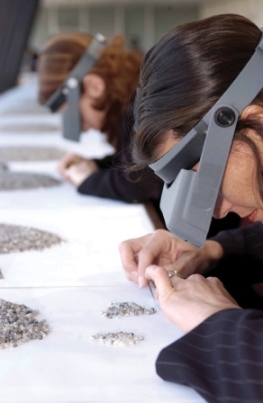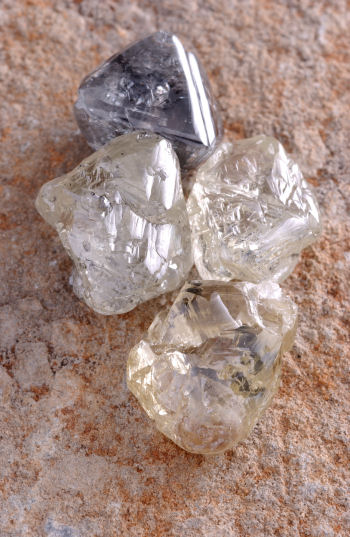IDEX Online Rough Diamond Market Report: Crystals Up, Color Down & Assortments Reexamined
November 15, 12
 |
There were no large price changes at the November DTC Sight, which was estimated at $550 million. Those changes that did take place were either small adjustments, both up and down, or a result of changes in box composition, such as the ratio between bigger and smaller goods in a particular box.
Two items stand out in the current market: the
The price of DTC's
According to manufacturers, the price is now right. It is a combination of the reduced rough price as well as the increase in demand and price of the polished output (see here an analysis of the appreciation of 1 ct Princess cuts). Therefore, demand for this box has increased from the previous rough cycle and is strong this week (see demand table below).
The larger crystal goods, the
Color Goods
Because the reduction in the price of white goods was relatively larger than that of color goods, the price gap between the two types of items has shrunk, harming demand for color. The rational is that with a little bit more money, a manufacturer can buy white goods and maybe get a better margin when offering the resulting polished to the market.
But this may have just changed. Last week, Alrosa belatedly reduced prices of the smaller (2 carats and below) color goods. This item, which is usually in good demand, was overpriced by Alrosa. As a result, it was essentially sitting on the shelf with limited interest from buyers. To reverse the situation, Alrosa reduced prices by an estimated 12 to 20 percent. We are told that the sharp drop in prices have created a little commotion in the market.
 |
Sightholders are starting to complain that the assortment of DTC boxes is not as consistent as before. Contracted buyers, such as a Sightholders, need to know that they are getting a steady supply. This is also important for box trading.
A sealed DTC box has a certain mystique, or as traders like to call it, “illusion.” A sealed box sells for more than the same DTC box once it has been opened. The contents may be exactly the same, but traders will refuse to pay full price.
The box consistency also means that transactions can be made over the phone. Buyers familiar with a box know what to expect to see in it, and are therefore willing to buy it blindly. If, however, consistency is lost, Sightholders believe that their supply is harmed and they, together with the second-hand buyers, lose confidence.
According to one industry member, some second hand buyers prefer non-DTC goods because of the perceived consistency issues as well as because of the lower price of other suppliers. As any retailer knows, without mystique – that is, a strong b
It is not clear why the DTC's boxes are suffering from this problem; nor do we know for sure which and how many are affected. One possible cause is the move of the sorting facility from
DTC Head of Communications, Louise Prior rejects this assessment. “We know from our data that consistency is still as accurate in our aggregation in
Another possible explanation voiced in the market is the decline in availability. Obviously, if the company does not have the goods; it can't put them in the box. This may explain why, for the third time this year, none of the Fancy boxes were offered, nor were there any Cold & Brown Clivage boxes at the last Sight.
There is a counter-claim in the market that the change is taking place among traders rather than in the goods. "The market is challenged and buyers examine boxes far more carefully today," an insider said. Therefore, if a single stone is at the far edges of the assortment, it stands out more than before.
Nothing Left Behind
As always, some of the boxes at the Sight were left on the table. The rejected boxes were offered to other Sightholders, and most of them were sold. Manufacturers, it seems, were less inclined to leave goods behind, contrary to dealers.
With a few Sightholders wondering why their colleagues bought so many goods, two of the people we spoke with said that some of the goods were taken for political reasons – either to demonstrate ability to the DTC or, if the boxes were not part of a trader’s regular supply, then they were bought in an attempt to inch into that category.
Secondary market trading is still slow. Although some traders believe they can make a profit, and a few boxes fetch a small premium, others still sold at DTC list price.
Outlook
Everything now hinges on the November-December holiday season. Good demand for diamond jewelry quickly runs up the diamond pipeline. One trader offered the following outlook: "In February-March profitability will increase to 10 percent, and in June-July we will suffer again from overpriced rough." It seems that any which way this is turned, at the end of the day, slim profitability remains the problem.
Now with Harry Winston expected to take over Ekati and BHP Billiton's Antwerp operations, it will be interesting to see if it will add its Diavik goods to the Ekati auctions, or pick a different sales model, for example a major contracted supply program.
Demand for Key DTC Boxes following November Sight
| Article | Demand | Remarks on Demand |
| Fine 2.5-4 ct & Fine 5-14.8 ct | Low demand for 2.5-4 ct and low demand for 5-14.8 ct | Better demand than last month. |
| Crystals 2.5-4 ct & | Medium demand for 5-14.8ct and Strong demand for 2.5-4 ct | Higher demand for 2.5-4 ct compared to previous Sight. |
| Commercial 2.5-4 ct | Low demand for 2.5-4 cts and 5-14.8ct | Similar demand compared to previous Sight. |
| Spotted Sawables 4-8 gr | High demand | Higher demand compared to previous Sight. |
| Chips 4-8 gr | Medium demand | Same demand compared to last Sight. |
| Colored Sawables 4-8 gr & Colored 2.5-14.8 ct | Medium demand for both sizes | Same demand compared to previous Sight. |
| Makeables High 3 gr +7 | Low demand | Slightly better than previous Sight. |
| Preparers Low 3-6 gr | Medium demand |
|
| 1st Color Rejections (H-L) +11/+7 | Medium demand | Better demand than previous Sight. |
| 1st Color Rejections (H-L) -7+3 | Low demand | Same demand as last Sight. |